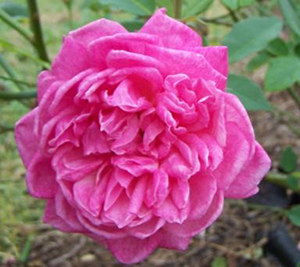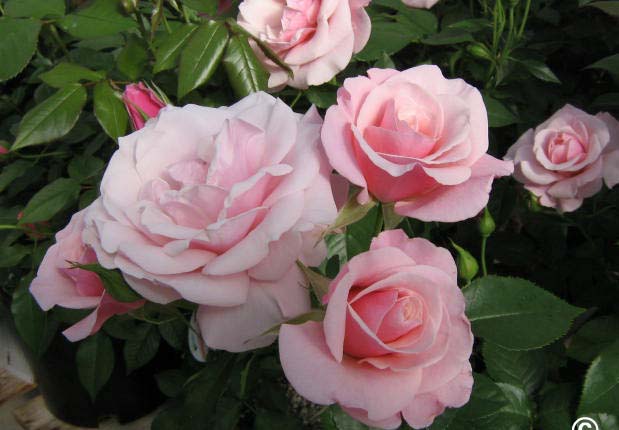A Rose By Any Other Name …
Types of Roses and Selection Criteria
By Janet Scheren, Fairfax Master Gardener
With all due respect to Shakespeare, roses comprise such a diverse group of flowers, they actually go by as many names as the fragrances, forms and colors they add to our gardens.

Native wild rose
Species or Wild Roses
These simple, hardy, disease resistant roses, developed in nature, can add substantial environmental value to your yard. They host more than 100 native butterfly species and have special value for native bees. In Virginia and much of the East Coast, Virginia Rose or Prairie Rose (Rosa virginiana) can be found from the dry uplands to the wetlands and sand dunes. Two other wild natives are the Swamp Rose (R. palustris) and Pasture Rose (R. carolina). All three have pink blossoms.
Do not confuse these beautiful native plants with the Multiflora Rose — R. multiflora — a native of Eastern Asia. This non-native, highly invasive rose is a small-leaved shrub with sprays of 1-inch (3 cm) white single roses in June. Multiflora roses should be removed from within 300 feet (90 m) of garden roses as they are the main host of the rose rosette disease, which can kill garden roses.

Old Garden Rose
Old Garden Roses
Gallica roses date back to Greek and Roman times. Together with Damask, Centifolia, Moss, Portland and Alba roses, Gallica roses form the oldest group of cultivated roses. Many of them have outstanding fragrances but bloom only once a year. The Damask rose is said to have been brought to Europe from the Middle East by the Crusaders. Together with the Centifolia rose, these two highly fragrant roses are commonly used in making perfume today.
A second subclass of old garden roses developed around 1792 with the introduction of the China Rose to Europe. There it was bred with other classes to achieve a repeat blooming rose that has changed the world of roses. This group also includes the Bourbon, Hybrid Perpetual, Noisette and Tea roses. Many old garden roses have found favor in today’s gardens. As a result, many are available at local garden centers, and others can be ordered online.
Modern Roses
The era of modern roses was established in 1867 with the introduction of the first hybrid tea rose. The American Rose Society divides modern roses in these five broad categories based on size of plant, size of bloom, and growth habit.

Hybrid Tea Rose ‘Memorial Day’
The most popular of the modern roses, hybrid teas roses feature large elegantly formed blooms with 30 to 50 petals, high pointed centers and long stems. Many are quite fragrant. While similar to hybrid tea roses, grandiflora roses can bear clusters of flowers.
Floribunda roses are characterized by large, profuse clusters of blossoms. Polyantha rose blossoms are smaller. Both create massive, colorful, long-lasting garden displays and tend to be hardier and more disease resistant than hybrid tea roses.
Miniature and Miniflora roses are bred to stay small in size and have smaller blooms as well. Some can be trained to climb supports, and others cascade over pots or walls.
Shrub roses are hardy and known for vigorous growth. They are profuse rebloomers with large quantities of flowers. With their sprawling habit, they can grow from 5 to 15 feet tall (2 to 5 m) and wide. Included in this group are Knock-Out Roses, which have brought roses to commercial landscapes as well as home gardens. The unique group of roses hybridized by David Austin, often called English Roses, also belongs to this class. These resemble old garden roses in shape and form but are recurrent bloomers that often have intense fragrance.

Floribunda Rose ‘Our Lady of Guadalupe’
Climbing and Rambling roses are defined by their growth habit. They have long arching canes with the ability to climb up fences, over walls and through trellises, arbors and pergolas, if properly trained and tied. They come in a wide range of flower forms, shapes and colors, including hybrid tea roses, floribunda roses, old garden roses and shrub roses. Climbing roses usually have large flowers and rebloom. Rambling roses tend to have numerous small- to medium-sized flowers held in large bunches, but typically flower only once a year. English rambling roses are cross-bred to repeat flower throughout the summer.
With so many roses to choose from, start by deciding how you plan to use the roses in your garden. You will also need to consider cultural factors, such as hours and orientation of sunlight, as well as how much care and maintenance you can provide. When selecting your roses, consider these criteria:
Specimen — If you are looking for a focal point, the upright form of the hybrid tea rose or the massive floral display of a grandiflora rose might fit the profile.
Enhanced Perennial Border — The more casual shape of a floribunda rose, shrub rose or English rose mixes well with perennials, annuals and shrubs. Mixing roses with other plants also reduces the risk of disease that can proliferate in a monoculture of roses.
Landscape Color — Modern rose cultivation has created the widest array of colors of any flower group: pure white, apricot, yellow, peach, coral, orange, pink, deep pink, lavender, red, crimson, purple, russet and blends.
Fragrance — With more than 30 compounds combining to create the fragrance of a particular rose specie, there is virtually an endless array of fragrances to choose from: apple, lemon, violet, green tea leaves, spice and musk to moss, hyacinth, orange, raspberry, melon or anise, to name a few. Old world roses and English roses are great selections to start in building a fragrant garden.
Meditation or Healing Garden — Climbing, old garden or English roses are good choices in creating a sanctuary for wellness or meditation.
Cut Flowers — Planting a few roses in a cutting garden or in a corner of your yard will provide extra flowers to bring into your home. Consider hybrid tea roses for their long-stemmed elegance or English Roses for their old rose form and heady fragrance.
Extended Blooming Season — A large proportion of roses are repeat bloomers that will grace your garden from spring to late fall, and sometimes deep into winter.
Lower Maintenance — Many roses can live happily in your landscape with a minimum of care and maintenance. Particularly easy to care for are the shrub roses and native roses.
Disease Resistance — Many of newer cultivars are bred for excellent disease resistance. Gardeners looking for lower maintenance gardens may also want to consider wild roses, old garden roses or shrub roses.
Other Considerations — Some roses have very few thorns. Others attract bees, can be shaped into a tree form or produce colorful rose hips for fall and winter interest. While most roses require six to eight hours of sun per day to thrive, some do quite well on a north facing wall or with only four or five hours of strong sun each day. Many grower websites allow you to search for these special considerations.
…updated 2024
- References
- A Rose Primer, Arlington Rose Foundation
- Roses: Selecting and Planting, Dave Trinklein, University of Missouri Extension
- Rose Types and Cultivars, Iowa State University Extension and Oureasch
- Roses, B. Rosie Lerner, Michael N. Dana, Cliff Sadof, Paul Pecknold, Purdue University Cooperative Extension Service